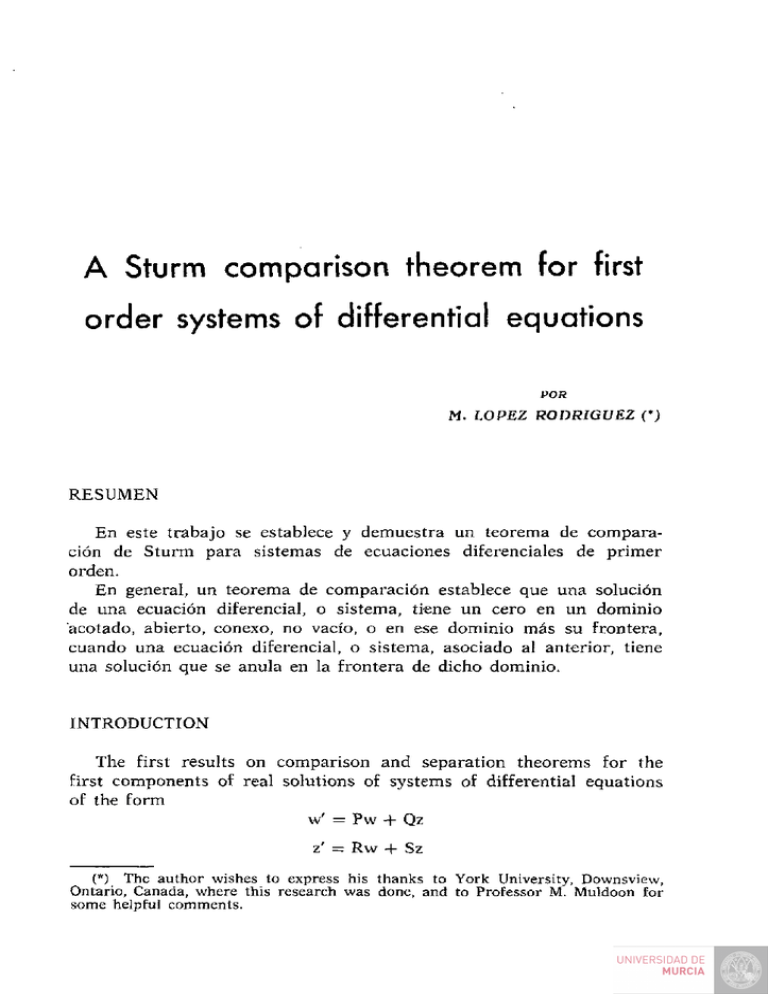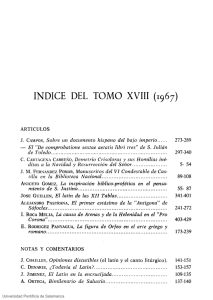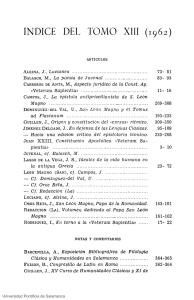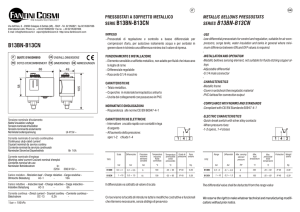A Sturm comparison theorem for first order systems of differential
Anuncio

A Sturm comparison theorem for first
order systems of differential equations
POR
M. LÓPEZ RODRÍGUEZ
(*)
RESUMEN
En este trabajo se establece y demuestra un teorema de comparación de Sturm para sistemas de ecuaciones diferenciales de primer
orden.
En general, un teorema de comparación establece que una solución
de una ecuación diferencial, o sistema, tiene un cero en un dominio
acotado, abierto, conexo, no vacío, o en ese dominio más su frontera,
cuando una ecuación diferencial, o sistema, asociado al anterior, tiene
una solución que se anula en la frontera de dicho dominio.
INTRODUCTION
The first results on comparison and separation theorems for the
first components of real solutions of systems of differential equations
of the form
w' = Pw + Qz
z' = Rw + Sz
(*) The author wishes to express his thanks to York University, Downsview,
Ontario, Canadá, where this research was done, and to Professor M. Muldoon for
some helpful comments.
112
M. López
Rodríguez
were obtained by M. Bócher [1] in 1902, by making use of the Riccati
equation. E. K a m k e [ 3 ] , in 1939, obtained the same results using the
Prüfer Transformation.
The comparison theorems of Bócher and K a m k e are results based
on pointwise inequalities among the coefficients of the systems, they
were not generahzed until recently, 1971, by J. B. Díaz and J. R. McLaughUn [ 2 ] , by means of an identity similar to Picone's [ 6 ] .
The following comparison theorem is based in conditions of a mixed
type, pointwise and integral inequalities, a n d generalizes the results
in [ 4 ] .
THEOREM
Suppose that wi, z¡, (i = 1, 2), is a non-trivial real-valued solution
in [a, b ] of the system
Wiv'
/Pi
QA
/ Wi \
z,/ ~
\R,
S,/
\z¡ /
where Pi, Qi, Ri, Si, are real-valued and continuous functions on [a, b ] .
Let a and -c be defined by
íT Wi(a) — zi(a) = O
T waCa) — Z2(a) = O,
and assume that
wi(b) = O, Wi(x)7^0
in
a —x<b.
F u r t h e r m o r e , suppose that
(1)
r
cr + \ (Ri +
j u
(SI — P i f
4 Q,
I
P
(S2 —P2)'
) dt I ^ T + I (R2 +
) dt
i
.; „
4 Q2
for a ^ X í á b, and that
(2)
/
QKx) =^ Q i ( x ) < O,
(
i ^ ' — ^1
S2 — P2
for a — X ^ b .
I
> ! 2V—Qi
2V—Q2
A Sturm
comparison
theorem
for first orders systems
113
Then, W2(x) has at least one zero in (a, b ] .
PROOF
Assume first that strict inequality holds in (1). We define two new
functions Ui, (i = 1, 2), by
Zi
Ui =
;
Wi
they satisfy the Riccati equations,
(3)i
u' = — Qi u' + (S, — POu + R,, (i - 1, 2)
with initial conditions Ui(a) = a , U2(a) = T.
Suppose that, contrary to the assertion of the theorem, W2(x) 7^ O
on [a, b ] . Then, (3)2 makes sense for all a —x — b , and we have
C^
(4)
2
C^
U2(x) = T + I •(—Q2U2)dt + i (S2 —P2)u2dt +
./a
.; a
/"x
C
í'\
+ I Rzdt = T + I (\/^^<)¡ U2 +
p
-Y dt +
; 2 V—Q2
r
+ I (R2 +
J «
(S2-P2f
)dt.
4 Q2
Since wi(x)7^0, a ^ x < b , (3)i has meaning for all x € [a, c],
vvhere a — c < b.
'
Therefore, Ui(x) is defined on [a, c] and in this interval,
(5)
ui(x) = ( 7 + |
(V=Q;U,+ ^
'^"
'-fát
2V=Q:
:r
(Si —p,)^
+ 1 (Ri +
) dt.
ja
2Ql
+
M. López
114
Rodríguez
We claim that | Ui(x) I < U2(x) for all x in [a, c ] , c € [a, b).
Indeed, from (1), (4) and (5) we have,
U2(X) > T +
I (R2 +
Ja
) dt >
4Q2
p
(Si — p.y
> — ( a + I (R. +
Ja
) dt)
^
4Q,
P
(Si — P J
p
(cr + I (Rj +
) dt + I (V—Qi u, +
Ja
4 Qi
J„
Si — P ,
-f dt) =
2V—Qi
= — ui(x),
for all
Let
X in
[a, c ] .
d = inf {x I U2(x)^Ui(x), a —X — b } .
Assume d — c. (Otherwise the claim holds).
Since a < d by hypothesis, w e have Ui(x) < U2(x) for all a — x < d,
and Ui(d) = Ua(d).
Therefore, U2(x) — | Ui(x) | in [a, d ] , and
Si — P i
Sa — Pa
V
V—Qi ui
Q2 U2 +
2V—Qa
+
2V—Qi
Si — P i
V—Qi ui +
2V—Qi
a^x^d,
Thus,
by (2).
"
S2 — P2
U2(d) = T + I (V—Q:2 U2 H
Ja
f
2V^^
dt+
(S2 — P.f
i (R2 +
J
) dt
4Q2
A Sturm comparison theorem for first orders systems
Si — P ,
+
(V—Qi ui +
^"
r
f dt +
2V=Q;
(S:
115
—Pi/
I (Ri +
-^^
) dt = ui(d),
'^'
contradicting the assumption Ui(d) = U2(d). This proves the inequality
I ui(x) I < U2(x) for all x in the interval [a, c ] , with a — c < b. The
same argument used in [5] proves | Ui(x) [ — U2(x) in [a, c], c € [a, b),
when we assume weak inequahty in (1).
The fact that U2 is continuous in [a, b] and the above result imply
the existence of a constant M such that
I u,(x) I < M
for all a — x < b. This contradicts the hypothesis
l i m Ui(x) = 00
x-*b
and proves that W2(x) has at least one zero in (a, b ] .
116
M. López
Rodríguez
REFERENCES
1.
M. BÓCHER, «On the real solutions of systems of two homogeneous linear
differential equatíons of the first order», Trans. Amer. Math. Soc, 3 (1902),
196-215.
2.
J. B. DlAz and J. R. MCLAUGHLIN, «Sturm comparison and separation theorems
for linear, second order, self-adjoint, ordinary differential equations and for
first order systems», Applicable Anal., 2 (1972), 355-376.
3.
E. KAMKE, «A new proof of Sturm comparison theorem», Amer. Math.
ly, 46 (1939), 417-421.
4.
K. K R E I T H , «Comparison theorems for nonselfadjoint differential equations
based on integral inequalities», Proc. Amer. Math. Soc, 34 (1972), 105-109.
5.
A. LEVIN, «A comparison principie for second order differential
Soviet Math. Dokl, 1 (1960), 1313-1316.
Month-
equations».
6. M. PiCONE, «Sui valori eccezionali di un parámetro da cui dipende un'equazione differentiale lineare ordinaria del second'ordine», Ann. Scuola
Nortn.
Sup., Pisa (1), 11 (1960), 1-141.
Universidad de Murcia


